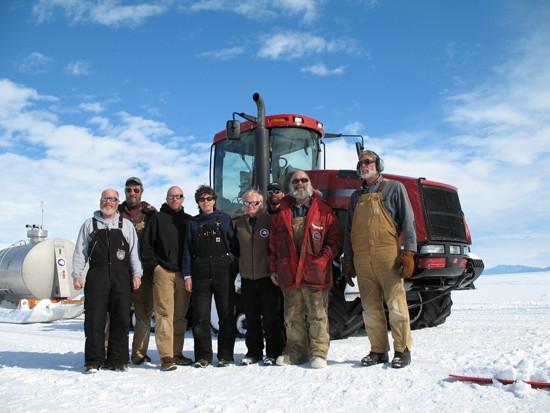|
Bottom of the world
Interactive presentation of one man's experiences during a two month drive across Antarctica.
|

Billings resident takes part in Antarctica expedition
By DONNA HEALY
Of The Gazette Staff
As the tractor convoy crossed Antarctica, the radar, mounted on a boom, jutted out 20 feet in front of the lead vehicle.
In the lead cab, Tom Lyman searched his computer screen for telltale signs of crevasses, cracks in the ice hidden below the snow's surface.
Images from the ground-penetrating radar gave him five to 10 seconds of advance warning, time to halt the lumbering caravan of tracked vehicles pulling heavily loaded sleds as it pioneered a path from Antarctica's coast to the South Pole.
The South Pole Traverse Project, which cost $5.8 million, was designed to test the viability of forging an overland route to deliver cargo towed by tractors from McMurdo Station, along Antarctica's coast, to the pole. The convoy inched along portions of the route over the course of three successive Antarctic summers, then completed the entire roundtrip journey in the fourth summer, arriving back at McMurdo Station in mid-January.

LARRY MAYER/Gazette Staff
Tom Lyman, of Billings, was the safety coordinator during the first and final years of the four-year South Pole Traverse Project, a 2,056-mile overland journey from Antarctica's coast to the South Pole.
At age 63, Lyman, who lives in Billings, was the oldest crew member, selected for his mountaineering expertise as the project's safety coordinator during the project's first and final summers. Most of the crew, composed of seven men and one woman, were adept at operating heavy equipment in polar climates.

Courtesy photo
The eight person team of the South Pole Traverse Project. Lyman was the oldest member of the group at 63 years-old.
The first year, a maze of gaping crevasses made moving across the polar ice cap like negotiating a minefield in vehicles weighing up to 86,000 pounds.
Some of the fissures, caused by the polar ice cap's constant movement, were a hundred feet deep and hundreds of feet long. The most treacherous of them lurked under the cover of unstable "snow bridges" formed by blowing snow.
To cross each crevasse, the crew drilled narrow holes through the thick snow bridges, lowering strings of dynamite through the holes. The blasts triggered massive, geyser-like eruptions of snow, although the snow muffled much of the sound and fury of the explosion.
After dynamiting each snow bridge, massive bulldozers scraped snow into the crevasse to plug the fissure, a job that could take six to eight hours. With each pass, the heavy-equipment operators drove the bulldozers perilously close to the edge of the crevasse.
During the first summer, the crew tackled the "shear zone," a 3- to 4-mile stretch where the Ross Ice Shelf, a slab of floating ice the size of France, meets the McMurdo ice stream, stretching and cracking the terrain into a maze of crevasses that have stymied every polar explorer.
"The first year, we crossed 24 big, big crevasses," Lyman said.
The deepest measured 113 feet. While crossing the shear zone, the crew detonated 5,700 pounds of dynamite.
"I would be the first one down in the crevasses, after we'd blown the bridges off, and I would rappel down to get the temperature measurements," Lyman said.
Frequently, his instruments would record temperatures of minus 60 to minus 70, although the surface temperature might be well above zero.
"It's pretty scary, actually, because you can't see either end of the crevasse," Lyman said. "It's just black, and you're looking up and there's this hole and you see the blue sky and then these giant things of ice just kind of hanging down over your head."
Big hunks of ice, loosened by the blasting, posed an ever-present threat.
Lyman, who has 40 years of mountaineering experience in cold climates, schooled crew members in crevasse rescue techniques. In Billings, Lyman works as a field engineer for the Plate Boundary Observatory, a National Science Foundation project that places sensors at strategic points to track the shifting of the Earth's tectonic plates in seismically active, earthquake prone regions.
While early-day explorers raced to the poles in disaster-prone dashes, the tractor-train convoy, organized by the National Science Foundation, cautiously inched overland toward the South Pole.
"We went 1,000 miles at 7 miles per hour," Lyman said. "Anybody who has driven a farm tractor for days plowing, it was about like that, except you're on ice instead of dirt."
In 1911, Norwegian explorer Roald Amundsen, the first to set foot on the South Pole, spent 99 days on his roundtrip from Antarctica's coast to the Pole.
The NSF's convoy took 67 days to make the 2,056-mile roundtrip journey.
The crew left McMurdo Station, the main U.S. base on Antarctica's coast, last November, at the start of the pole's austral summer season, and arrived at the South Pole two days before Christmas. They returned to McMurdo Station in mid-January.
Unlike the first polar explorers, the crew listened to iPods or books on tape, downloaded e-mail from satellites and supped on catered, pre-packaged dinners.
Amundsen's dogs pulled four sledges.
The convoy of tracked vehicles delivered nearly 110 tons of cargo, the equivalent of 11 plane loads of equipment and supplies.
Historically, all cargo has been ferried to the South Pole station by airplanes, mostly LC-130s, landing on skis along ice runways.
In 1958, Sir Edmund Hillary, who led the first successful ascent of Mount Everest, arrived at the South Pole leading a small group of men riding modified Massey Ferguson farm tractors, but the idea of delivering massive amounts of cargo along an overland route had never been tested.
To pick the best route, they used satellite imagery and marked their trail with flags mounted to bamboo poles. During the first summer, the crew traveled only 40 miles inland because of the difficulty of crossing the shear zone. The second summer, they traveled 550 miles, crossing the Ross Ice Shelf.
In the third year, the expedition went another 100 miles, climbing the Leverett Glacier to go over the Transantarctic Mountains. Retracing the previous years' route, and forging across 350 miles of new terrain, Lyman and the seven other crew members crossed the Polar Plateau to complete the entire roundtrip journey.
Although the convoy's members ran into no difficulty with crevasses once they reached the Polar Plateau, in the continent's interior, wind whipped the snow into sastrugi -- long, wave-like, frozen ridges -- for at least 150 miles.
"It looks like if you were looking at the ocean on a stormy day and you see the waves curling and then breaking and foam, and then all the sudden it froze instantly like that, almost as hard as rock," said Lyman, who is still recovering from a bruised kidney caused by the brutal pounding of the rugged terrain.
"It's like driving down a railroad track in a junker truck missing one wheel and the rest of them are all steel, square wheels."
Within 60 miles of the pole, the convoy became mired in very soft snow, which necessitated unhooking tractor loads and ferrying partial loads across the high-elevation plateau.
In an age of supersonic transport, it's hard to conceive of how slowly the tractor-train convoy traveled. On their best day, they made 85 miles. Some days, they went two or three miles before a machine would break down or they would encounter other obstacles.
While the weather was relatively warm, averaging around 5 degrees below zero, ground blizzards sometimes forced layovers.
Hurricane-force winds shook the 15,000-pound "living module," a towed container outfitted with a kitchen and bunks. A second portable building, their "energy module," contained generators, equipment for heating snow into drinking water, an electric toilet and even a tiny, stacked washer/dryer unit made in Italy.
The convoy included Lyman's Jeep-sized tracked vehicle, which resembled the snow-grooming machines common on ski slopes, followed by a bulldozer and seven tractors towing sleds loaded with cargo, fuel and the living and energy modules.
"One of the tractors broke down about 250 miles out, and we had to drag it all the way to the pole," Lyman said.
The most impressive piece of equipment they delivered was the world's largest snow hauler. The 62,000-pound snow trailer, which the crew nicknamed "Snow White," can be loaded with about 30 tons of snow, making it more efficient than bulldozers plowing snow from the pole's airplane runways.
They also experimented with dragging fuel in bladders reinforced with Kevlar on top of plastic sleds. The empty bladders weigh less than metal fuel tanks and collapse when empty.
Supporting researchers at the South Pole is expensive, and fuel is one of the main costs. Last summer, fuel made up 45 percent of the total cargo transported to the pole via LC-130 aircraft. The planes burn more than a gallon of fuel for every gallon they deliver.
Relying solely on planes to deliver cargo has meant that every object at the pole, including the new South Pole Station that is under construction, must fit inside the cargo bay of an LC-130 or be re-engineered to arrive in pieces and be reassembled on site. During the Antarctic summer, planes land several times a day on the South Pole's ice runways. Using land convoys to deliver fuel and equipment would also free up airplane flights for scientific work.
Some environmental groups opposed the traverse because of the potential for damaging the pristine polar wilderness. Others worry that a flagged route will attract adventure travelers.
"They called it a road. It isn't a road. It's a trail really because it's not maintained," Lyman said.
The idea was to create a path that tractor-train convoys could use once or twice a season to ferry supplies. While the feasibility of using the overland route is still being analyzed, the NSF budget request for fiscal 2007 includes funds to allow for full-scale traverse operations in the future.
Because the ice in polar regions moves at an average speed of 1.1 inches a day, global positioning technology cannot be used with the same accuracy as elsewhere in the world. The flags, mounted on poles, moved with the ice, allowing the crew to retrace its route.
"We had bamboo flags as trail markers every quarter of a mile for one-thousand miles," Lyman said.
While the crew moved from flag to flag, the one thing they failed to spot on their long march was Emperor penguins, the continent's iconic image. While smaller, Adelie penguins live near McMurdo Station, Emperor penguins live across the continent and on the opposite side of the Ross Ice Shelf from McMurdo Station.
Contact Donna Healy at dhealy@billingsgazette.com or 657-1292.
